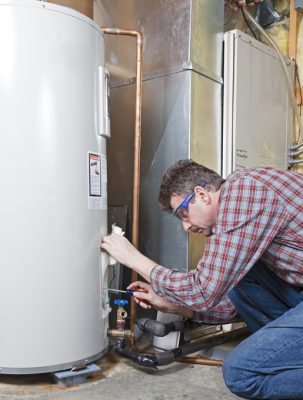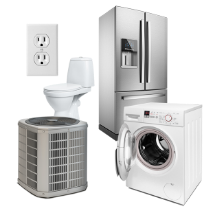It’s a smart idea to maintain your water heater. Here are some reasons why.
- It could cost you $1,790 on average to replace your water heater.
- Proper maintenance can extend a water heater’s life.
- Maintaining your water heater isn’t terribly difficult.
Let’s look at some of the ways you can maintain your water heater, extend its life and protect your budget.
Before you start maintenance on your water heater, follow safety protocols
Before starting any maintenance on your water heater, gather the following materials:
- Gloves
- Goggles
- Non-flammable clothing
Some repairs are easy, such as checking the pressure relief valve or flushing the tank. But you’ll still be working with extremely hot water and potentially flammable materials. So, you want to keep yourself protected. If you are uncomfortable working around electricity and gas, contact a professional.
The following maintenance checklist will provide you with a guide for how to maintain your water heater, whether it’s got a tank or is tankless.
Check the temperature-and-pressure valve
The temperature-and-pressure valve, or T&P valve, opens to release pressure and cool your water when operating correctly. It prevents explosions if your water heater ever overheats or overpressurizes your water.
Checking it to make sure it’s not faulty can save your water heater, your home and even your life. To check it, simply follow these steps.
- Turn off the pilot light. Don’t simply blow out the light. The safest method is to turn off the gas supply or electricity to the water heater.
- Locate the T&P valve. Refer to your water heater’s owners manual. Your T&P valve is likely located on either the side or top of your water heater. If you have an electric, on-demand tankless water heater, you may not have a pressure valve at all.
- Try to open the valve’s trip lever. You should be able to open the valve’s trip lever easily. When lifting the trip lever, listen for a rush of air. It should sound like opening a 2-liter bottle of soda or like air flowing out of a bike tire.
If you don’t hear any air rushing out of the T&P valve, you need to replace it. It’s faulty and isn’t doing its job. If this is the case, you have a few options.
- Call a professional to replace it. A professional technician can help you address T&P valve issues. However, you’ll need to find, vet and hire a technician and pay for everything out of pocket.
- Submit a claim using your 2-10 Home Buyers Warranty (2-10 HBW) home warranty. When appliances like a water heater break down, a home warranty from 2-10 HBW can come in handy. For a service fee of usually less than $100, you can have a qualified and approved Service Contractor on the job to assess and address your issue.
- Try to replace it yourself. If you choose to do this, be very careful. Water heater repair can be dangerous. Here’s a brief video to give you an idea for what you’d be in for:
https://www.youtube.com/watch?v=nG8R9_bNAmw
Flush the water heater tank
If you have a water heater with a tank, you need to flush it to remove sediment buildup. This sediment can make your water heater inefficient, leading to higher utility costs. It can also clog your water line or rust through steel.
To flush your water heater tank, follow a few simple steps.
- Turn off the electricity to the water heater or turn off the gas to turn off the pilot light.
- Shut off the cold-water supply to the water heater.
- Connect a garden hose to the tank’s drain valve, which is located near the floor.
- Place the open end of the hose either over a floor drainage grate, into a large bucket or run it outside. This is how you’ll drain the water. Be careful! The water you drain may be scalding hot.
- Open your T&P valve to release the tank’s pressure before draining.
- Open the drain valve and drain completely. Once the water that’s draining out is clear, you’re finished draining.
- Close the drain valve, disconnect the water hose and close the pressure valve.
- Open all the hot-water spigots in your house.
- Turn on the cold-water supply to the tank.
As water begins to flow from each hot-water spigot, close them. After you close your last spigot, turn on the electricity to the water heater or turn on the gas. You’re done!
Lighting the pilot light on a gas water heater
Lighting the pilot light on a gas water heater is fairly simply maintenance.
- Start by setting the control knob to the pilot setting and switching the gas valve to the on
- Press the control knob.
- Push the igniter button.
Once you light the pilot light, you’ll see a blinking light and a small flame. Just set the temperature to 120°F, and you’re done!
Reconnecting electric power to your electric water heater
If you have an electric water heater, take note. Reconnecting electric power to your electric water heater before the tank is completely full of water may cause the upper heating element to burn out.
If you need to replace your heating element, follow these steps to replace the heating element before connecting the power to your electric water heater. You’ll need to purchase a replacement heating element first.
- Turn off power to the unit and drain the water tank.
- Disconnect the wires from the heating element and unscrew it using an element wrench.
- Insert the replacement element and tighten.
- Reconnect the wiring.
- Open a hot-water faucet and let the water run for 3 minutes to ensure all air is removed and the tank is full of water.
- Turn the power back on.
Within 2 hours, you should have hot water. If not, you’ll need to check to make sure the water heater is getting the proper voltage. Call an electrician if you continue to have electrical issues.
While maintenance can extend your water heater’s life, it will eventually break down. To protect yourself from unexpected breakdowns, purchase a home warranty from 2-10 HBW.
2-10 HBW offers the most comprehensive home warranty coverage for homeowners. Let us help you protect your home.








